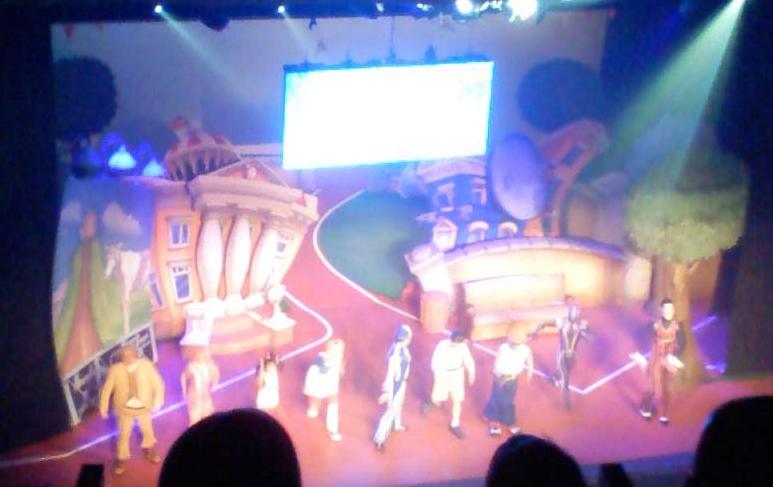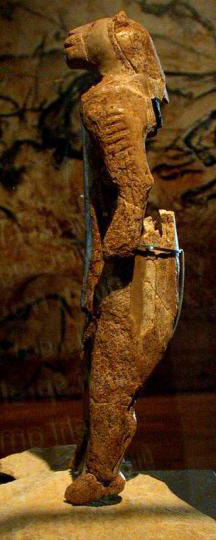|
The Pinky And Perky Show
''The Pinky and Perky Show'' is a 2008 revival of Pinky and Perky. It stars the two anthropomorphic pigs. It is in full CGI and produced by Method Films and Picture Production Company, and in association with Pinky and Perky Enterprises. 52 episodes were produced. Plot The show stars the Pigs named Pinky and Perky, together they run their children's show called The Pinky and Perky Show. Together they handle different situations whether being bringing a band back together, trying to get the most stickers and even finding lost treasure. Pinky is the kind hearted pig and animator of the cartoon "The Adventures of Power Pig and Porker" while his other brother Perky is spoilt and takes things for granted. Setting Unlike the original puppet series, the show is set in a world of anthropomorphic animals, such as K.T., a cat who serves as the show organizer; Wilberforce, a turtle who works as the security guard; Vera, a fox who hosts a morning show; and Eric, a dog who serves as Ve ... [...More Info...] [...Related Items...] OR: [Wikipedia] [Google] [Baidu] |
Jan Dalibor
Jan Dalibor (5 May 1921 – 23 July 2013) and his wife Vlasta Dalibor (born Vlasta Cely, 22 May 1921 – 21 February 2016) were Czech-born British puppeteers, responsible for devising and developing the characters Pinky and Perky on children's television in the 1950s and 1960s. Biography Vlasta Cely was born in Brno, and became friends with Jan Dalibor as a child. She attended a language school and the Janáček Academy of performing arts while Jan taught an art class, but after the Nazi annexation of Czechoslovakia he was made to work in a factory and she became secretary to a businessman. They married after the end of World War II, and in 1948 escaped from the new Communist regime by making their way to Austria. Arriving as refugees in Britain, they settled in Yorkshire. Jan worked in a stone quarry at Tadcaster as a miner, and Vlasta worked as a housemaid in Houndhill. [...More Info...] [...Related Items...] OR: [Wikipedia] [Google] [Baidu] |
Glenn Gregory
Glenn Peter Gregory (born 16 May 1958) is a British singer, songwriter and multi-instrumentalist whose music career spans more than 40 years. He came to prominence in the early 1980s as co-founder and lead singer of the new wave and synth-pop band Heaven 17, which released several UK chart hits in the 1980s and 1990s, including “Temptation”, “ Let Me Go”, “ Come Live with Me”, “ Crushed by the Wheels of Industry”, “ Sunset Now”, “ This Is Mine”, and “ (We Don't Need This) Fascist Groove Thang” Early years Glenn Peter Gregory was born on 16 May 1958 in Sheffield, England. His father, Howard, was a steel worker. As a teenager, he wanted to be an actor, but he worked in London as a photographer. Music career In 1977, Gregory was part of the band 57 Men, formed by Jack Hues and Nick Feldman, who both later formed the band Wang Chung. Gregory knew the founding members of the Human League The Human League are an English synth-pop band formed in S ... [...More Info...] [...Related Items...] OR: [Wikipedia] [Google] [Baidu] |
LazyTown
''LazyTown'' () is an Icelandic children's educational musical television series created by aerobics champion Magnús Scheving. Originally produced in English, it has been broadcast in dozens of languages globally. Designed to encourage healthy lifestyles, the series was based on Scheving's stage play '' Áfram Latibær!'', itself adapted from a book that Scheving wrote in 1995. The series was commissioned by Nickelodeon in early 2003, following the production of two stage plays and a test pilot. Originally performed in English, it was later dubbed into thirty languages and broadcast in over 180 countries. It combines live action, puppetry and computer animation, making it one of the most expensive children's shows, with the cost per episode being over five times that of the average children's show. The first two seasons, consisting of fifty-two episodes, were produced from 2004 to 2007. ''LazyTown'' originally aired on Nickelodeon's Nick Jr. block in the United States and t ... [...More Info...] [...Related Items...] OR: [Wikipedia] [Google] [Baidu] |
Granada International
ITV Studios Limited is a British multinational television media company owned by British television broadcaster ITV plc. It handles production and distribution of programmes broadcast on the ITV network and third-party broadcasters, and is based in 12 countries across 60 production labels, with local production offices in the UK, the US, Belgium, Australia, Germany, the Netherlands, Italy, Israel, France, Spain, and Scandinavia. About ITV Studios not only makes programmes primarily for its parent company ITV plc, but also for other networks such as the BBC and Channel 4. It was formed from a gradual amalgamation of the production divisions of all ITV plc owned 'Channel 3' licensees which occurred from 1994 to 2004, and for a number of years thereafter following the creation of ITV plc. The division is also responsible for ITV's production facilities The London Studios, 3SixtyMedia (based at ITV Granada, and co-owned with BBC Studioworks), and location hire company ProVisio ... [...More Info...] [...Related Items...] OR: [Wikipedia] [Google] [Baidu] |
Anthropomorphic
Anthropomorphism is the attribution of human traits, emotions, or intentions to non-human entities. It is considered to be an innate tendency of human psychology. Personification is the related attribution of human form and characteristics to abstract concepts such as nations, emotions, and natural forces, such as seasons and weather. Both have ancient roots as storytelling and artistic devices, and most cultures have traditional fables with anthropomorphized animals as characters. People have also routinely attributed human emotions and behavioral traits to wild as well as domesticated animals. Etymology Anthropomorphism and anthropomorphization derive from the verb form ''anthropomorphize'', itself derived from the Greek ''ánthrōpos'' (, "human") and ''morphē'' (, "form"). It is first attested in 1753, originally in reference to the heresy of applying a human form to the Christian God.''Oxford English Dictionary'', 1st ed. "anthropomorphism, ''n.''" Oxford University Pr ... [...More Info...] [...Related Items...] OR: [Wikipedia] [Google] [Baidu] |
Computer-generated Imagery
Computer-generated imagery (CGI) is a specific-technology or application of computer graphics for creating or improving images in Digital art, art, Publishing, printed media, Training simulation, simulators, videos and video games. These images are either static (i.e. still images) or dynamic (i.e. moving images). CGI both refers to 2D computer graphics and (more frequently) 3D computer graphics with the purpose of designing characters, virtual worlds, or scenes and Visual effects, special effects (in films, television programs, commercials, etc.). The application of CGI for creating/improving animations is called ''computer animation'', or ''CGI animation''. History The first feature film to use CGI as well as the composition of live-action film with CGI was ''Vertigo (film), Vertigo'', which used abstract computer graphics by John Whitney (animator), John Whitney in the opening credits of the film. The first feature film to make use of CGI with live action in the storyline of ... [...More Info...] [...Related Items...] OR: [Wikipedia] [Google] [Baidu] |
Anthropomorphism
Anthropomorphism is the attribution of human traits, emotions, or intentions to non-human entities. It is considered to be an innate tendency of human psychology. Personification is the related attribution of human form and characteristics to abstract concepts such as nations, emotions, and natural forces, such as seasons and weather. Both have ancient roots as storytelling and artistic devices, and most cultures have traditional fables with anthropomorphized animals as characters. People have also routinely attributed human emotions and behavioral traits to wild as well as domesticated animals. Etymology Anthropomorphism and anthropomorphization derive from the verb form ''anthropomorphize'', itself derived from the Greek ''ánthrōpos'' (, "human") and ''morphē'' (, "form"). It is first attested in 1753, originally in reference to the heresy of applying a human form to the Christian God.''Oxford English Dictionary'', 1st ed. "anthropomorphism, ''n.''" Oxford University ... [...More Info...] [...Related Items...] OR: [Wikipedia] [Google] [Baidu] |
Pinky And Perky
''Pinky and Perky'' is a children's television series first broadcast by BBC One, BBC TV in 1957, and revived in 2008 as an animated adaptation. Original series The title characters are a pair of anthropomorphic puppet pigs, named Pinky and Perky, who were originally going to be named Pinky and Porky but there was a problem registering Porky as a character name. This was solved by Margaret Potter, the wife of their producer, Trevor Hill, who also discovered them, when she woke him up one night announcing "I've got it! Pinky and Perky!" They were created by Czechoslovakian immigrants Jan and Vlasta Dalibor who moved to the village of Houndhill, leaving the pigs under the cupboard in The Bungalow. The characters of pigs were chosen because the pig is seen as a symbol of good luck in the former Czechoslovakia. The puppets, who had only very limited movements, looked very alike. Pinky wore red clothes and Perky wore blue, but this distinction was of little use on monochrome TV, so P ... [...More Info...] [...Related Items...] OR: [Wikipedia] [Google] [Baidu] |
Revival (television)
In television, a revival is a television series that returns to produce new episodes after being off the air for a certain amount of time, particularly due to cancellation. Definition Network executives may decide to attempt to revive a television program when they feel that a market once again exists for it. It is one of several programming strategies television networks employ to capitalize further on successful programs; among the other methods are spin-offs, reboots, remakes, cast reunions, television movies and sequels. Unlike spin-offs, in which a television network creates an entirely new series around an existing character or setting, a revival reintroduces most or many of the original program's storylines, characters, and locales, and usually attempts to resolve story arcs that the original run failed to complete, as opposed to a sequel that may introduce a new storyline with some of the same characters after the previous series' story ended. Revivals usually t ... [...More Info...] [...Related Items...] OR: [Wikipedia] [Google] [Baidu] |
France 3
France 3 () is a French free-to-air Public broadcasting, public television network. The second flagship network of France Télévisions, it broadcasts a wide range of general and specialized programming. France 3 is structured as a Regional variation, regional service with 13 regions, each of which carrying programmes of regional interest alongside the national schedule. These include local news and current affairs programmes, programmes highlighting the region, and in some areas, programmes presented in regional languages. Since the 2020s, France 3 has also collaborated with Radio France's regional service Ici (radio network), Ici, with France 3's news bulletins falling under the ''Ici'' title, and the two services simulcasting the breakfast programme ''Ici Matin''. The network first launched by the Office de Radiodiffusion Télévision Française (ORTF) on 31 December 1972 as the Troisième Chaîne Couleur. In January 1975, as part of the separation of the ORTF, the netw ... [...More Info...] [...Related Items...] OR: [Wikipedia] [Google] [Baidu] |
CBBC (TV Channel)
CBBC is a British free-to-air public broadcast children's television channel owned and operated by the BBC. It is also the brand used for all BBC content for children aged 6 to 12. Its sister channel, CBeebies, is aimed at children aged 6 and under. It broadcasts every day from 7:00 am to 7:00 pm, timesharing with BBC Three. History Launched on 11 February 2002 at the same time as its sister channel CBeebies, the CBBC name (a contraction of Children's BBC) has been used from 1997 onwards to brand all content on BBC One and BBC Two aimed at children. It has continued to be used as a brand on these channels even after regular weekday broadcasting was discontinued in 2012. Prior to the dedicated channels' launch, there were CBBC strands on other cable and satellite stations. First, on Nickelodeon as CBBC on Nickelodeon between 1996 and 1999, and on BBC Choice with exclusive programmes as CBBC Choice between 1998 and 1999 and airing repeats as during the daytime as CBBC on Cho ... [...More Info...] [...Related Items...] OR: [Wikipedia] [Google] [Baidu] |
DQ Entertainment
DQ may stand for: In arts and entertainment *''Dragon Quest'', a series of console role-playing games created by Enix * ''Dragon Quest'' (video game), The first game in the series released in 1986 * ''DragonQuest'', a 1980 role-playing game created by SPI Businesses * Dairy Queen, a fast food chain * Coastal Air Transport (IATA code DQ) People * DQ (artist), Danish singer, participant in Eurovision Song Contest 2007 * Dan Quayle, American politician * Dulquer Salmaan, Indian actor and singer * Dan Quinn (American football), football coach In science and technology * HLA DQ, a human leukocyte antigen type protein * Data quality, various measures in information science * Design qualification, part of verification and validation * Digital Intelligence Quotient, a form of intelligence that combines knowledge in information technology and the socio-emotional ability to interact effectively through this medium * Double-ended queue, a data type in computer science In sport * Disqualif ... [...More Info...] [...Related Items...] OR: [Wikipedia] [Google] [Baidu] |




